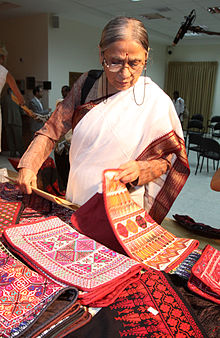Self-Employed Women's Association of India | |
| Founded | 1972 |
|---|---|
| Headquarters | Ahmedabad |
| Location | |
Members | 1,916,676 (2013) |
Key people | Ela Bhatt, Founder |
| Affiliations | ITUC |
| Website | www.sewa.org |


Self-Employed Women's Association (SEWA), meaning "service" in several Indian languages, is a trade union based in Ahmedabad, India, that promotes the rights of low-income, independently employed female workers.[1] Nearly 2 million workers are members of the Self-Employed Women’s Association across eight states in India. Self-employed women are defined as those who do not have a fixed employer-employee relationship and do not receive a fixed salary and social protection like that of formally-employed workers and therefore have a more precarious income and life.[2] SEWA organises around the goal of full employment in which a woman secures work, income, food, and social security like health care, child care, insurance, pension and shelter.[3] The principles behind accomplishing these goals are struggle and development, meaning negotiating with stakeholders and providing services, respectively.[4][3]
SEWA was founded in 1972 by labor lawyer and organiser Ela Bhatt. It emerged from the Women's Wing of the Textile Labour Association (TLA), a labour union founded by Gandhi in 1918.[5] The organisation grew very quickly, with 30,000 members in 1996, to 318,527 in 2000, to 1,919,676 in 2013.,[2][6] and nearly 2 million in 2023.[7] Even before the financial crisis of 2008, over 90% of India's working population was in the informal sector (Shakuntala 2015), and 94% of working women in 2009 worked in the informal sector (Bhatt 2009).[8][9] India's history and patriarchal systems also contributes to this disparity because traditional gender roles exclude women from regular, secure forms of labour.[10]
- ^ Howard Spodek (October 1994). "Review: The Self-Employed Women's Association (SEWA) in India: Feminist, Gandhian Power in Development". Economic Development and Cultural Change. 43 (1). University of Chicago Press: 193–202. doi:10.1086/452141. JSTOR 1154338. S2CID 155233844.
- ^ a b Rekha Datta (Spring 2003). "From Development to Empowerment: The Self-Employed Women's Association in India". International Journal of Politics, Culture and Society. 16 (3): 351–368. doi:10.1023/A:1022352227601. JSTOR 20020171. S2CID 140446037.
- ^ a b "About Us: Introduction". Self Employed Women's Association.
- ^ Martha Chen; Chris Bonner; Françoise Carré (2015). "Organizing Informal Workers: Benefits, Challenges and Successes". UNDP Human Development Report. 2015 UNDP Human Development Report Office: 13.
- ^ Spodek, Howard (2011). Ahmedabad: Shock city of the twentieth century India. Bloomington, Indiana: Indiana University Press. pp. 253. ISBN 978-0253355874.
- ^ Annual Report (PDF) (Report). Self Employed Women's Association. 2013. p. 4.
- ^ Oza, Rupal. The Making of Neoliberal India. pp. 21–44.
- ^ Das, Shakuntala (2015). "Growing Informality, Gender Equality and the Role of Fiscal Policy in the Face of the Current Economic Crisis: Evidence from the Indian Economy". International Journal of Political Economy. 44 (4): 277–295. doi:10.1080/08911916.2015.1129846. S2CID 155891885.
- ^ Cite error: The named reference
:3was invoked but never defined (see the help page). - ^ Edward Webster (2011). "Organizing in the Informal Economy: Ela Bhatt and the Self-Employed Women's Association of India" (PDF). Labour, Capital and Society. 44 (1): 99–125.